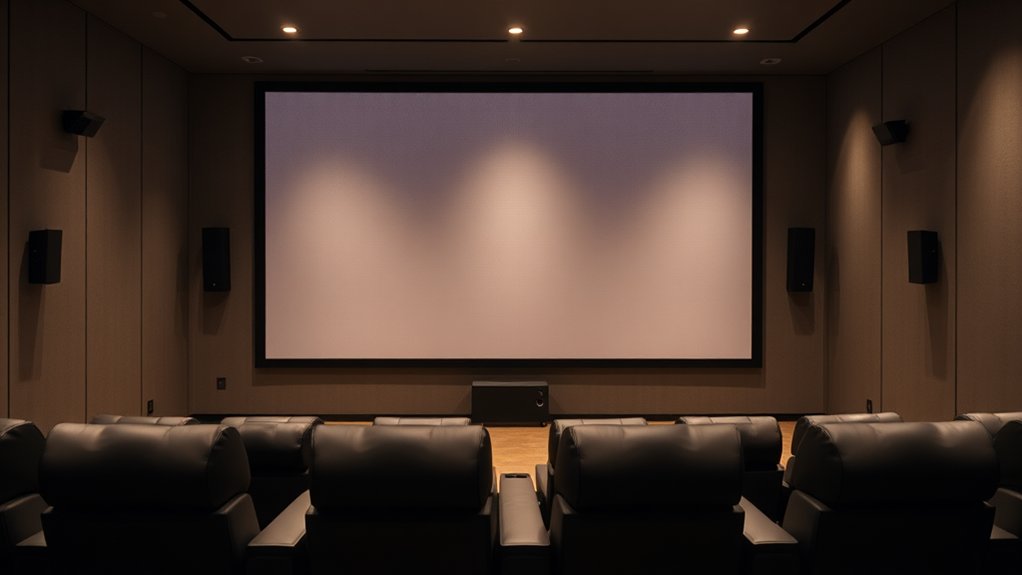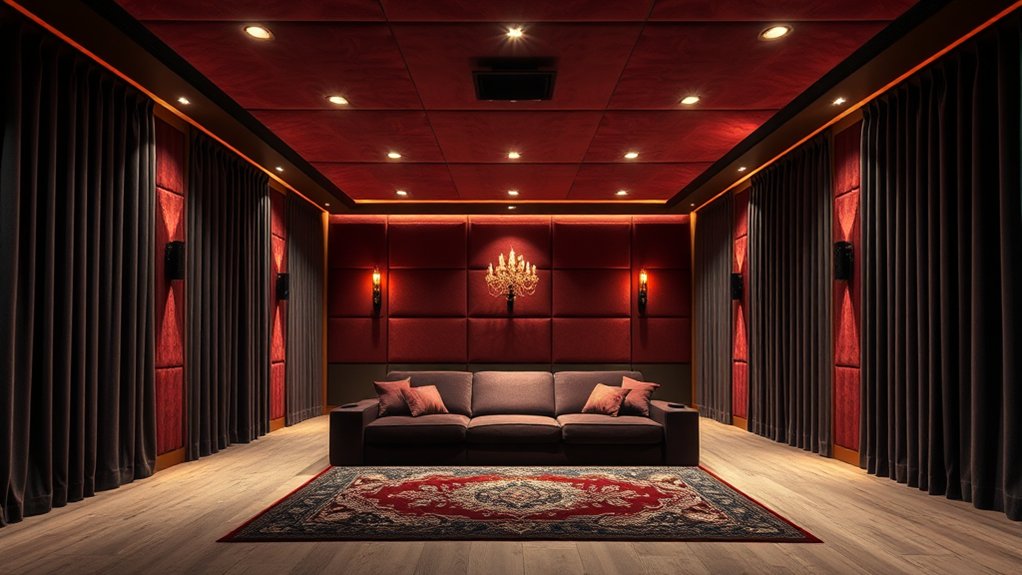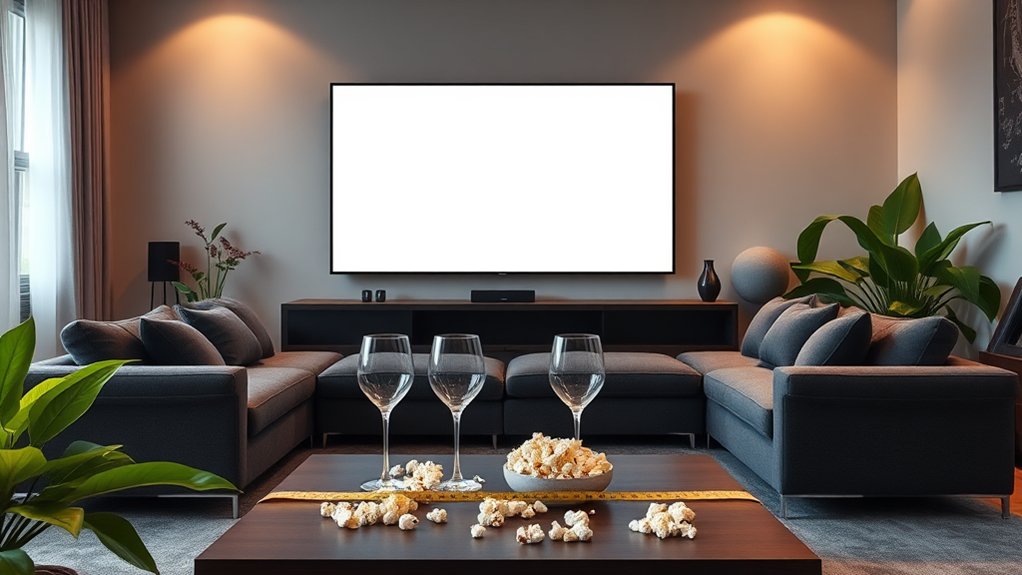Choosing acoustic transparent home theater screens is a smart move if you want to improve your viewing and listening experience. These screens let sound waves pass through without distortion, making voices seem like they’re coming from the characters on screen—pretty cool, right? Plus, they create a clean look by hiding speakers, freeing up wall space for larger displays. With the right installation and design, you can achieve both stunning visuals and clear audio. Curious about how to set it all up?
Key Highlights
- Acoustic transparent screens allow sound to pass through, enhancing audio clarity while maintaining video quality for a superior viewing experience.
- Hiding speakers behind the screens creates a minimalist aesthetic, reducing visual clutter in your home theater setup.
- Proper placement of acoustic transparent screens aligns sound with visuals, improving realism and dialogue clarity for viewers.
- The use of woven or perforated materials ensures minimal distortion, allowing for immersive sound experiences comparable to commercial theaters.
- Motorized acoustic screens can retract when not in use, maximizing space and flexibility in room layout without sacrificing performance.
The Science Behind Acoustic Transparency
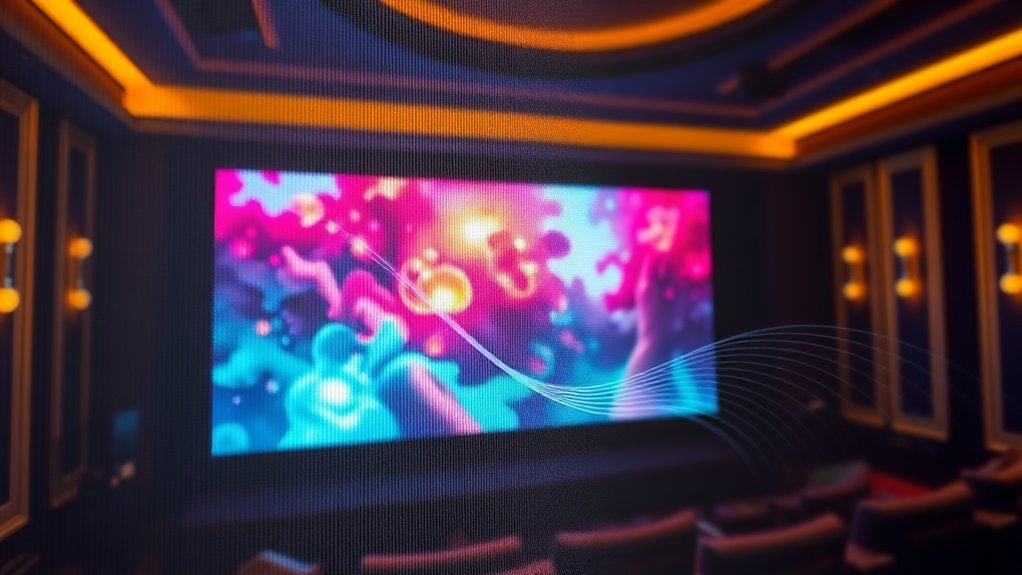
Imagine you’re in a theater, the lights dim, and the climactic scene unfolds—only to feel like the characters are speaking from a distance, rather than right in front of you.
That’s where acoustic transparent screens shine. These specially designed screens let sound waves pass through with minimal distortion, ensuring the audio aligns perfectly with the visuals. By placing your center channel speaker directly behind the screen, dialogue feels more realistic, as if the actors are voicing their lines just inches away. In addition, these screens allow for seamless integration of audio and video, creating a more engaging viewing experience.
Think about it: wouldn’t you rather hear the characters as if they’re right in the room? Plus, using woven fabrics or perforated materials maintains image quality as well as enhancing sound, striking that sweet balance between visual delight and auditory clarity. This technology is particularly beneficial for creating immersive experiences that reflect the quality found in commercial theatres.
Types of Acoustic Transparent Screens
When you’re diving into the world of acoustic transparent screens, it helps to know that they typically fall into two main categories: woven and perforated.
Woven screens, made from a coarse fabric, allow sound to pass through with minimal loss, maintaining both audio fidelity and a smooth image surface. These screens may have lower gain, which affects brightness, but they’re ideal for Ultra-High Definition content. Additionally, woven screens are known for their acoustically transparent designs that enhance theater performance. Speakers can be placed behind woven screens to achieve optimal soundstage positioning.
Conversely, perforated screens feature tiny holes designed to balance sound transmission and image clarity, though their installation can be finicky. Meanwhile, they deliver sharper images. However, too dense or large perforations can affect sound quality.
Enhancing Sound Quality With Screen Placement
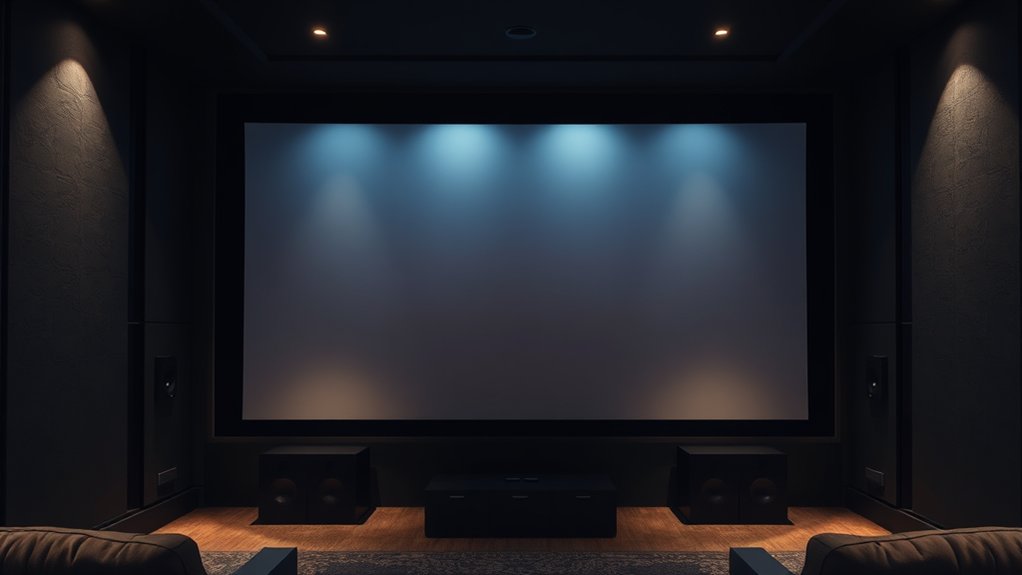
To improve the sound quality in your home theater, it’s vital that you consider the placement of your acoustic transparent screen.
By positioning this screen in front of your front speakers, especially the center channel, you create a perfect alignment between sound and visuals. Imagine voices appearing directly from the characters, enhancing realism and making you feel part of the action. Additionally, using acoustic transparent screens helps ensure that sound emanates from onscreen action, further elevating your viewing experience. The setup allows for minimized vibrations, which contributes to clearer sound reproduction.
When your speakers are behind the screen, you’ll avoid the muddled sound that often occurs with traditional setups. Plus, this configuration frees up wall space, allowing for larger screens and better viewing angles.
Aesthetic Advantages of Acoustic Transparent Screens
Acoustic transparent screens not only improve your sound experience, but they as well offer an array of aesthetic advantages that make them a stylish choice for any home theater setup.
By hiding speakers behind the screen, you eliminate clutter caused by visible grilles and equipment, creating a clean, minimalist look that complements your room’s decor. This design frees up screen edges, allowing for larger images without compromise.
You can even use motorized screens that retract neatly, improving the overall aesthetic when not in use. Plus, with improved spatial harmony, you’ve got flexibility in room layout, keeping everything visually cohesive.
In the end, these screens maintain visual integrity, ensuring vivid images while effortlessly integrating sound and sight—who wouldn’t want that?
Key Installation and Design Considerations
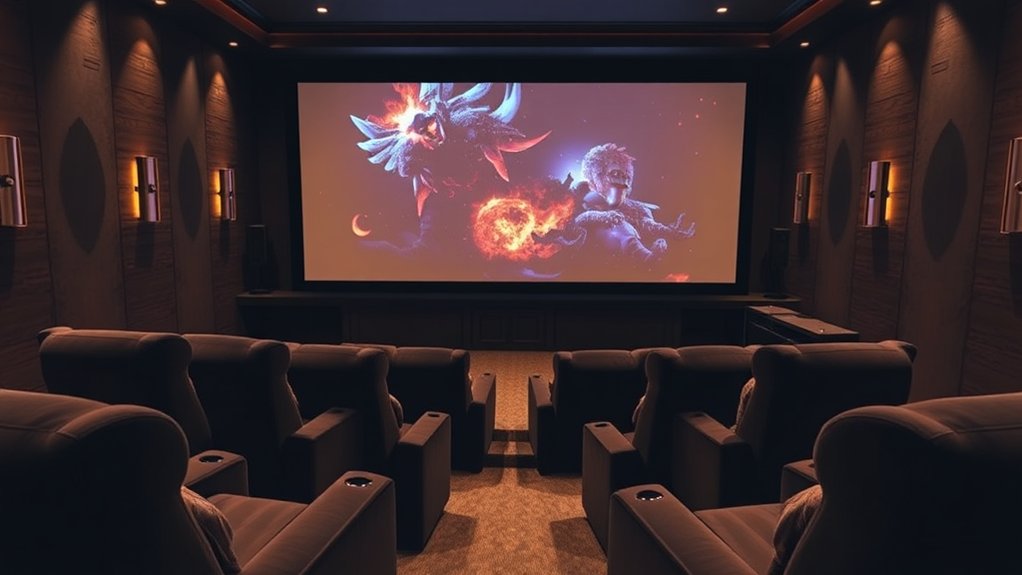
Choosing the right installation and design considerations isn’t just about achieving optimum performance; it’s also about creating a seamless viewing experience that improves your home theater setup.
You’ll want to allocate enough space behind the screen for speakers, during ensuring the wall can support the screen’s weight without a hitch. Precision is key, so align everything carefully to maintain that perfect viewing angle.
Don’t forget about lovely little details like selecting high-quality fabrics—Accupix or Accupix Pro—because no one wants a projector turning images into a blurry mess.
Plus, consider speaker placement; that center channel behind the screen is crucial for making dialogue sound crystal clear.
Trust me, a little extra planning will pay off in the big screen excitement!
Practical Benefits for Home Theater Experiences
When you step into a home theater, the excitement isn’t just about the giant screen or plush seating; it’s also about the sound experience that pulls you into the action.
With acoustic transparent screens, you can position the speakers directly behind, aligning the audio with what’s happening on screen. Imagine hearing a car zoom past, precisely where it’s racing in the film. This setup eliminates common audio localization issues, ensuring dialogue remains clear and immersive.
Positioning speakers behind acoustic transparent screens creates an immersive sound experience, aligning audio precisely with on-screen action.
Furthermore, woven materials reduce distortion and improve sound quality, meaning subtle effects won’t get lost in translation.
You’ll appreciate the minimalist design too; hiding speakers keeps your space clean and sleek. Who wouldn’t want a visually stunning setup with exceptional sound quality?
Making the Right Choice for Your Setup
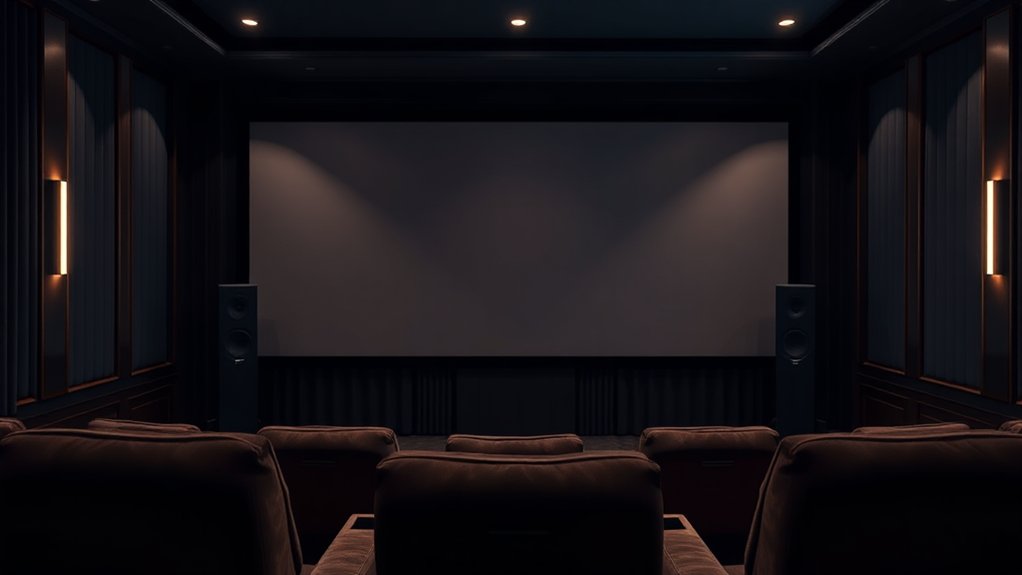
The right home theater setup can greatly improve your viewing and listening experience, so understanding your options is key.
First, consider speaker placement. Acoustic transparent screens allow you to position speakers behind the screen, syncing audio with visuals for a more immersive experience—no one wants their dialogue coming from a different direction, right?
Next, choose your screen material wisely: woven fabric reduces moiré patterns, whereas perforated screens might need extra tuning but offer professional quality.
Finally, don’t underestimate aesthetics; a clean, uncluttered look improves your space and keeps the focus on what really matters: your movie.
Balancing visual clarity with sound performance isn’t just science; it’s part of creating your ideal home theater. Enjoy the magic!
Frequently Asked Questions
How Do Acoustic Transparent Screens Affect Room Acoustics?
Acoustic transparent screens improve room acoustics by allowing speakers to align with the screen, reducing sound reflections and distortion. This setup elevates clarity, providing a balanced sound distribution for a more immersive audio experience in your space.
Can I Use Any Speakers Behind an Acoustic Transparent Screen?
No, you can’t use just any speakers behind an acoustic transparent screen. Guarantee they meet specific requirements for size, enclosure type, and distance from the screen to optimize sound quality and avoid distortion.
Do Acoustic Transparent Screens Require Special Maintenance?
Yes, acoustic transparent screens require special maintenance. Use a damp microfiber cloth for light cleaning every three months, and avoid harsh chemicals or abrasive materials to preserve their sound and image quality.
Are Acoustic Transparent Screens Suitable for Outdoor Use?
Acoustic transparent screens can be suitable for outdoor use, but they require strong materials and weatherproofing to withstand environmental factors. You’ll likewise need to take into account maintenance and proper installation to guarantee ideal sound and image quality.
What Are the Best Projector Types for These Screens?
For acoustic transparent screens, laser and DLP projectors are your best bets. They offer high brightness, excellent color reproduction, and sharpness, ensuring vivid images during minimizing any visible screen mesh or perforation patterns.

